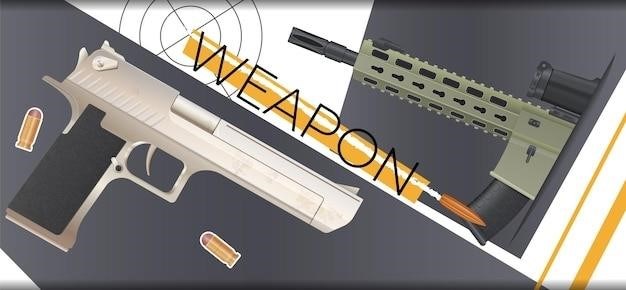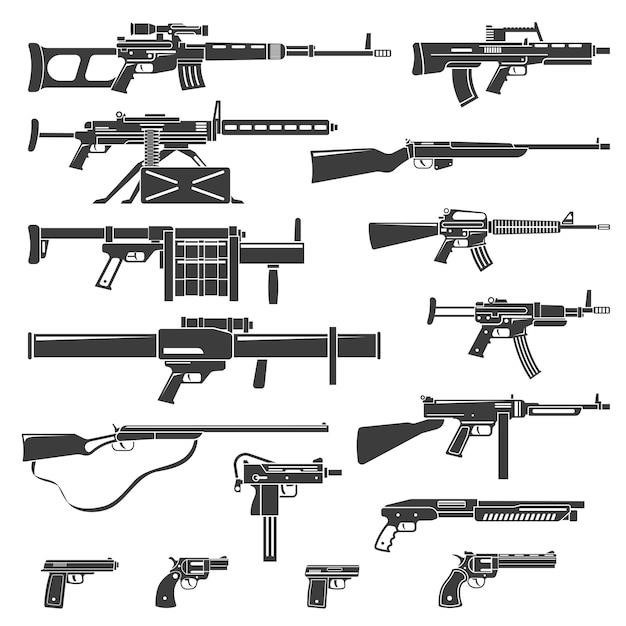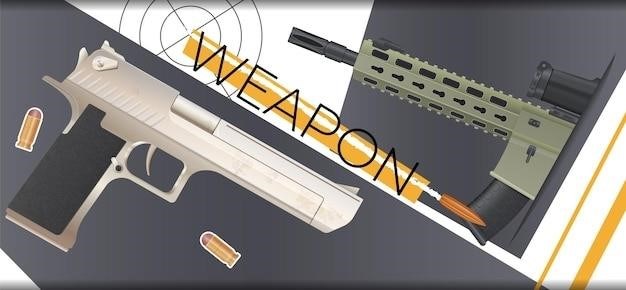MG34 and MG42 Machine Guns⁚ A Comprehensive Guide
This comprehensive guide delves into the history, design, and legacy of the MG34 and MG42 machine guns, two iconic weapons that played a pivotal role in World War II. Explore their technical specifications, operational manuals, and modern replicas, gaining insights into their enduring impact on military history and firearms enthusiasts alike.
Introduction
The MG34 and MG42 machine guns are two of the most iconic and influential firearms of the 20th century. Developed in Germany during the interwar period, these weapons revolutionized machine gun design and profoundly impacted the course of World War II. The MG34, with its innovative design and versatility, became the standard machine gun of the German Wehrmacht, while the MG42, renowned for its high rate of fire and robust construction, earned the nickname “The Buzzsaw” for its distinctive sound. This guide aims to provide a comprehensive overview of these legendary weapons, exploring their technical specifications, historical significance, and enduring legacy.
The MG34⁚ A Revolutionary Design
The MG34, introduced in 1934, represented a significant departure from traditional machine gun designs. Its innovative features included a unique roller-locked operating system, a lightweight, air-cooled barrel, and a remarkably versatile design that allowed it to be used as both a light and heavy machine gun. The MG34’s ability to be mounted on a bipod, tripod, or even fired from the shoulder made it a highly adaptable weapon for a wide range of battlefield situations. Its accuracy and reliability were also highly regarded, contributing to its widespread adoption by the German military.
The MG42⁚ The “Buzzsaw” of WWII
The MG42, introduced in 1942, quickly gained notoriety as the “Buzzsaw” for its distinctive high rate of fire, reaching a staggering 1,200 rounds per minute. This rapid fire capability, combined with its robust design and ease of maintenance, made the MG42 a formidable weapon on the battlefield. Its distinctive sound, described as a “whizzing” or “buzzing” noise, was a source of fear and respect among Allied soldiers. The MG42’s high rate of fire and effectiveness in suppressing enemy fire played a significant role in German military tactics during World War II.
Technical Specifications and Comparisons
Both the MG34 and MG42 were gas-operated, air-cooled machine guns chambered for the 7.92×57mm Mauser cartridge. However, they differed in several key aspects. The MG34, a more complex and refined design, featured a higher rate of fire, reaching around 800 to 900 rounds per minute, but was also heavier and more expensive to manufacture. The MG42, on the other hand, adopted a simpler and more cost-effective design, resulting in a higher production rate and a lower cost. Its design prioritized reliability and ease of maintenance, making it a more practical choice for mass production during wartime.
MG34
The MG34, introduced in 1934, was a revolutionary machine gun that set the standard for future designs. Its versatility allowed it to be used as a light machine gun with a bipod, a heavy machine gun with a tripod, or even as an anti-aircraft weapon with a specialized mount. The MG34’s design incorporated advanced features like a quick-change barrel, a unique feed system, and a high rate of fire. However, its complex manufacturing process and the use of expensive materials made it costly to produce, ultimately hindering its widespread adoption.
MG42
The MG42, introduced in 1942, was a significant evolution over the MG34, prioritizing simplicity and production efficiency. Its design incorporated a stamped sheet metal receiver, simplifying manufacturing and reducing costs. The MG42 was renowned for its high rate of fire, earning it the nickname “Buzzsaw” for its distinctive sound. While it lacked the versatility of the MG34, its ruggedness, reliability, and ease of use made it a formidable weapon in the hands of German soldiers. The MG42’s impact on military technology and its iconic status continue to captivate firearm enthusiasts and historians alike.
Operational Manuals and Resources
For those seeking in-depth knowledge of the MG34 and MG42, a wealth of resources is available, including original and translated operational manuals. These manuals provide a detailed understanding of the guns’ operation, maintenance, and field use. Several online platforms and dedicated websites offer digitized versions of these manuals, making them accessible to researchers, collectors, and enthusiasts. Notably, English translations of original German manuals are readily available, facilitating a comprehensive understanding of these iconic weapons’ inner workings and historical significance.
MG34 Operators Manual
The MG34 Operators Manual, often referred to as the “Butz Manual,” is a comprehensive guide for operating and maintaining the MG34 machine gun. This manual, originally published in German, has been translated into English, making it accessible to a wider audience. The Butz Manual covers a wide range of topics, including assembly, disassembly, cleaning, lubrication, firing procedures, troubleshooting, and even detailed parts diagrams. Its detailed instructions and clear illustrations make it an invaluable resource for anyone seeking to understand the MG34’s intricacies.
MG42 Operators Manual
The MG42 Operators Manual, designated as H;Dv. 216/6, is a crucial document for understanding the operation and maintenance of the MG42 machine gun. While the original manual was written in German, translated versions are available, making it accessible to English-speaking enthusiasts. The manual provides detailed instructions on assembling, disassembling, cleaning, and lubricating the MG42. It also covers firing procedures, safety precautions, and troubleshooting common issues. The H.Dv. 216/6 is a valuable resource for anyone seeking a thorough understanding of the MG42’s workings, offering a comprehensive guide for both novice and experienced users.
MG42 Armorer Manual

The MG42 Armorer Manual, known as HDv 181/7, is a technical handbook specifically designed for those responsible for the inspection and repair of the MG42 machine gun. It is a comprehensive guide for armorers, providing detailed information on the weapon’s internal mechanisms, troubleshooting common malfunctions, and conducting thorough repairs. This manual is a valuable resource for individuals seeking to understand the intricacies of the MG42’s design and to acquire the skills necessary for its proper maintenance and repair. It offers a deep dive into the weapon’s inner workings, making it an essential companion for those seeking to become proficient in the art of MG42 maintenance.
Other Available Manuals
Beyond the core operator and armorer manuals, a wealth of additional resources exists for those seeking a deeper understanding of the MG34 and MG42. These manuals offer specialized information on specific components, accessories, and even the Lafette tripod. For instance, a dedicated MG34 Lafette manual provides detailed instructions on its assembly, operation, and maintenance. These supplementary manuals are crucial for those seeking a complete picture of the MG34 and MG42, allowing them to explore the nuances of their operation and maintenance in greater depth. Whether focusing on specific accessories, maintenance procedures, or the Lafette tripod itself, these manuals offer valuable insights for both enthusiasts and professionals.
Historical Significance and Legacy
The MG34 and MG42 left an indelible mark on military history, influencing tactical doctrine and shaping the course of World War II. The MG34, with its revolutionary design and versatility, revolutionized the role of the machine gun in the battlefield. Its ability to be used as both a light and heavy machine gun provided unmatched flexibility, enabling German troops to adapt to diverse combat scenarios. The MG42, with its rapid rate of fire and reliable operation, became a symbol of German firepower, earning the nickname “Buzzsaw” for its distinctive sound. The legacy of these weapons extends beyond their military impact. Their influence can be seen in the design of later machine guns, while their iconic status continues to fascinate historians, collectors, and enthusiasts worldwide. The MG34 and MG42 stand as testaments to German engineering prowess and their lasting impact on the development of firearms.

Modern Replicas and Collectors’ Interest
The enduring fascination with the MG34 and MG42 has led to the production of modern replicas and a thriving collector’s market. Companies like DISA and Hamp;K have produced replicas of the MG34 and MG42, allowing enthusiasts to experience these historical firearms in a modern context. These replicas are often meticulously crafted, capturing the details and aesthetics of their original counterparts. The collector’s market for these guns is robust, with original MG34 and MG42s fetching substantial prices. Collectors are drawn to the historical significance, engineering ingenuity, and sheer firepower of these weapons, making them sought-after pieces for military history enthusiasts and firearms collectors alike. The continued popularity of these machine guns in modern replicas and among collectors is a testament to their enduring legacy.
The MG34 and MG42 machine guns stand as testaments to German engineering prowess and their impact on military history is undeniable. Their innovative designs, impressive firepower, and enduring legacy continue to captivate enthusiasts and collectors alike. From their revolutionary features to their widespread use in World War II, these machine guns represent a significant chapter in firearms development. The MG34 and MG42 continue to inspire awe and fascination, serving as reminders of the technological advancements and the enduring appeal of these iconic weapons.
